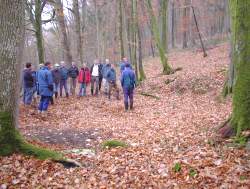We use some essential cookies to make this website work.
We’d like to set additional cookies to understand how you use forestresearch.gov.uk, remember your settings and improve our services.
We also use cookies set by other sites to help us deliver content from their services.
 Features and sites forming part the historic environment provide the tools with which we can understand our past. They are a finite, non-renewable resource, and once lost, can not be replaced. To allow the interpretation and study of the historic environment by future generations, management to ensure its preservation is required whenever possible. Many people have a strong affinity towards the human past and archaeological trails are very popular as walkers try to imagine the lifestyle of their ancestors.
Features and sites forming part the historic environment provide the tools with which we can understand our past. They are a finite, non-renewable resource, and once lost, can not be replaced. To allow the interpretation and study of the historic environment by future generations, management to ensure its preservation is required whenever possible. Many people have a strong affinity towards the human past and archaeological trails are very popular as walkers try to imagine the lifestyle of their ancestors.
It is Forestry Commission policy to increase public access to its woodlands and recreation, tourism, health and well-being are considered of greater importance today than they have been in the past. Some Forest Districts are now utilising their cultural assets and creating heritage walks with information signs that incorporate features of interest. Such trails attract more visitors to the woodland and thus provide both health and educational benefits.
Cookies are files saved on your phone, tablet or computer when you visit a website.
We use cookies to store information about how you use the dwi.gov.uk website, such as the pages you visit.
Find out more about cookies on forestresearch.gov.uk
We use 3 types of cookie. You can choose which cookies you're happy for us to use.
These essential cookies do things like remember your progress through a form. They always need to be on.
We use Google Analytics to measure how you use the website so we can improve it based on user needs. Google Analytics sets cookies that store anonymised information about: how you got to the site the pages you visit on forestresearch.gov.uk and how long you spend on each page what you click on while you're visiting the site
Some forestresearch.gov.uk pages may contain content from other sites, like YouTube or Flickr, which may set their own cookies. These sites are sometimes called ‘third party’ services. This tells us how many people are seeing the content and whether it’s useful.